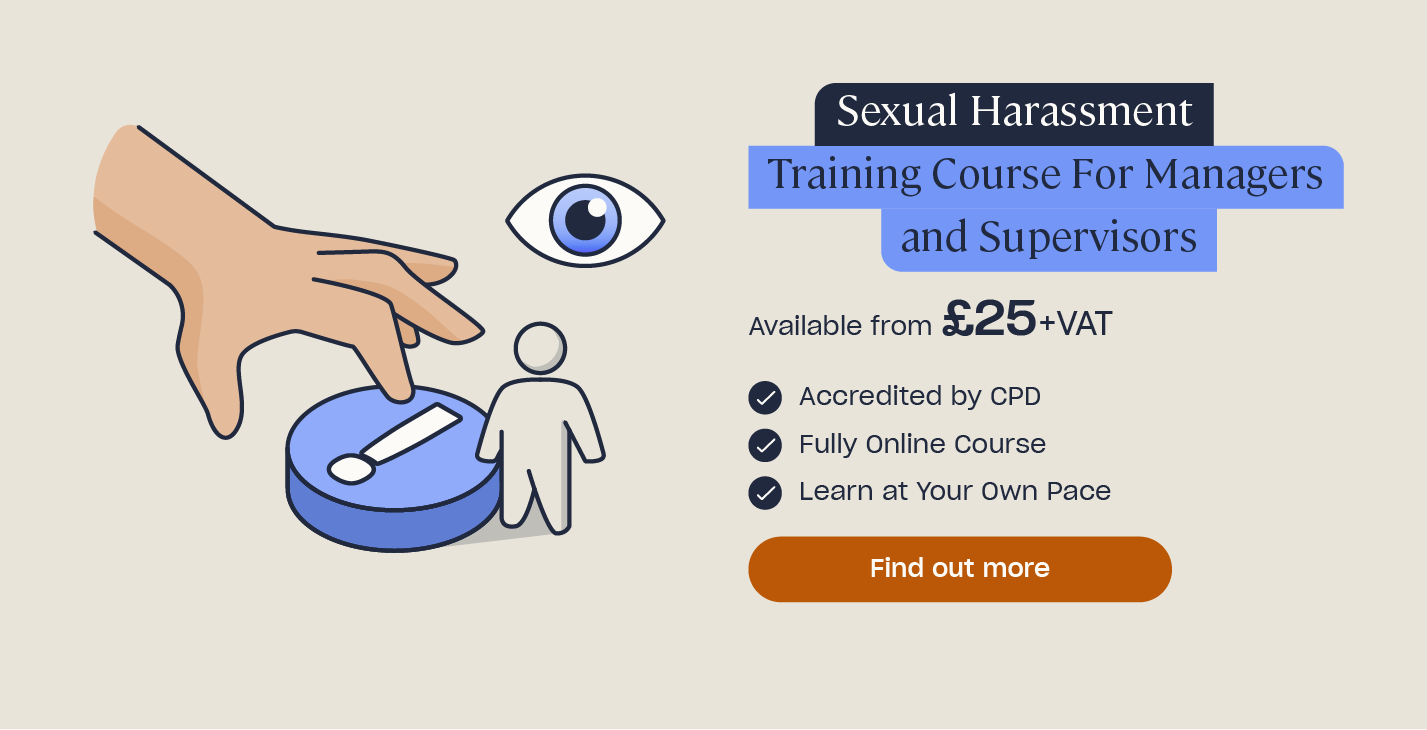Preventing Sexual Harassment in the Workplace: Employer Responsibilities
Everyone has the right to feel safe and comfortable in their workplace. People thrive in work environments where they feel respected and trust their colleagues. Unfortunately, sexual harassment is a growing issue in society and, in particular, in the workplace. In 2019, a government questionnaire received 4,215 responses, with 54% of people reporting that they had experienced sexual harassment at work.
Despite this enquiry highlighting the need for better protection for employees from sexual harassment at work, a more recent survey from 2023 showed that women, in particular, were still experiencing this behaviour. Results showed that 58% of the women participants had experienced sexual harassment, bullying or verbal abuse at work.
As an employer, manager or supervisor, you have a responsibility to protect your employees from harassment. In this article, we will explain what sexual harassment is, how to recognise when it is happening and how to prevent it from happening in your workplace.
What Constitutes Sexual Harassment in the Workplace?
Anybody who experiences unwanted sexual behaviour, whether this be verbal or physical, is a victim of sexual harassment. There is a vast array of behaviours that can be classed as sexual harassment, from unwanted closeness, touching, or asking personal questions to verbal abuse or sexual assault.
The key thing to remember is that if a person feels uncomfortable as a result of any sexualised behaviour made towards them, then it constitutes sexual harassment. In some cases, a person may say they didn’t mean to cause offence or make someone feel uncomfortable, but this doesn’t make it acceptable. It is also important to ensure that sexual harassment is never passed off as ‘banter’ or a joke, and no one should ever be made to feel that they are wrong for feeling uncomfortable.
Need a course?
Our Sexual Harassment Training Course for Managers and Supervisors explains what sexual harassment is in more detail, and outlines ways to prevent it in your workplace.
Examples of Sexual Harassment in the Workplace
As stated previously, sexual harassment can present itself in many forms, and you should always be vigilant and observe the behaviours of your employees. The people you manage or supervise will want to know they can trust you to intervene appropriately should you notice any signs of sexual harassment.
Some examples to look out for include:
- Comments or ‘jokes’ of a sexual nature.
- Inappropriate remarks or personal, sexual questions. For example, asking another person how many sexual partners they’ve had.
- Sexual propositions or bribes, such as offering to help a colleague at work in return for going out for a drink or on a date.
- Emails or messages of a sexual nature or that include sexual content.
- Posting inappropriate comments on social media, such as commenting about a person’s appearance in a picture they’ve shared.
- Inappropriate hand gestures or facial expressions.
- Unwanted physical contact, including touching, hugging, unwelcome sexual advances and all forms of sexual assault.

What are the Effects of Sexual Harassment in the Workplace?
Despite everyone having the right to feel safe and comfortable in their workplace, sexual harassment in the workplace is still a prevalent issue. Experiencing sexual harassment at work has significant effects on the victim but also the wider organisation.
Potential effects can include:
- Poor mental health and wellbeing. Nobody should experience sexual harassment. Those who do are likely to experience issues such as worry, anxiety and depression. These emotions can be exhausting and easily transfer into all aspects of their life, meaning their wellbeing is seriously affected. The importance of mental health and how to promote positivity at work is discussed in our article here.
- Damaged working relationships. This not only goes for the relationship between the individual who is being harassed and the person harassing them, but also other working relationships across the organisation. If others notice this behaviour is happening and not being addressed or challenged, they will lose trust in the ethos and values present. Also, if the victim does not feel listened to or as though any issues they raise have been taken seriously, this can lead to them losing faith or trust in their colleagues or management.
- Reduced productivity. If a person is dealing with sexual harassment, it will likely take up a lot of their focus. They may feel unable to concentrate at work and are much less likely to feel motivated.
- Absenteeism. In some cases, victims of sexual harassment may feel unable to attend work. This has huge implications for an organisation’s functionality and reflects extremely poorly on the culture that has been created. Reducing absenteeism is discussed in our article here.
How to Prevent Sexual Harassment in the Workplace: Employer Responsibilities
Anybody who manages or leads people should be mindful of the wellbeing of their employees and aim to create a positive culture in the workplace that promotes respectful and professional behaviours.
Below are five tips that can help you to do this and hopefully prevent sexual harassment in your organisation:
1. Educate Your Employees
You should educate all your employees about sexual harassment. They need to know the definition of sexual harassment, behaviours that are included in this definition, and what steps they should take if they’re being harassed. You should also tell them what to do if they notice that someone else is a victim of harassment or if someone else has disclosed information to them.
Provide your employees with examples of sexual harassment and how they may look in real life contexts. It may be the case that people are unaware they’re engaging in sexually harassing behaviour until you provide them with examples. They may believe their behaviour could be seen as a ‘joke’; however, once they see that their behaviour is inappropriate, they will be compelled to reconsider.
Educating your workforce doesn’t have to be time-consuming. Online sexual harassment training courses give your staff the opportunity to train at their own pace whilst not disrupting their usual activities.
2. Educate Senior Members of Staff
Just as you’d educate your workforce, it’s just as important that you educate your senior members of staff. Everybody has a responsibility to prevent sexual harassment and report it if they witness it. Additionally, everyone needs to know what constitutes sexual harassment and understand that it must always be addressed and challenged.
3. Develop a Thorough Sexual Harassment Policy
All workplaces are expected to have a sexual harassment policy in place. This should contain:
- An opening statement detailing your zero-tolerance approach to sexual harassment.
- The definition of sexual harassment alongside examples of what constitutes sexual harassment so that all employees are clearly informed.
- Details of how employees can report instances of sexual harassment.
- Details of how sexual harassment will be dealt with.
- An explanation of disciplinary procedures for those who engage in sexual harassment.
Your policy must be relevant to all employees at all levels and should be reviewed and updated frequently.
4. Design a Thorough Reporting Procedure
It’s essential that you design a thorough procedure for reporting any cases of sexual harassment, and it must be simple and easy. You should communicate the procedure to all employees and have it somewhere they can easily access it, such as in the staff handbook or on a company intranet.
Your reporting procedure must be fair and transparent. Under no circumstances must you treat someone differently because they’ve made a complaint. You should also keep all cases confidential unless you have an adequate reason for not doing so, such as calling the police.
Respond to any sexual harassment claims quickly and without delay. When you take immediate action, you show employees that you react to these situations seriously and won’t tolerate them. Moreover, if your reaction is delayed, the harasser may continue with the behaviour.

5. Create a Positive Work Culture
Having a positive workplace culture means you have an environment where people feel respected and valued, where you recognise and appreciate their work, and where there is a sense of community. Having a workplace of this kind dramatically reduces the risk of sexual harassment.
You should ensure that everyone in your business knows your values, and you should communicate this to everyone. Encourage team-building activities, arrange social events that everyone can participate in and celebrate the achievements of individuals and teams. You should also encourage positive communication across the entire organisation.
As an employer, manager, or supervisor, you are responsible for preventing sexual harassment in the workplace. Creating a safe and secure environment where your organisation’s values and culture are respected should be a priority, and your employees should feel safe and secure at work. You must develop a policy that clarifies that any form of harassment won’t be tolerated, and employees should be encouraged to report any instances. This will result in a happy and productive workforce.
What to Read Next:
- Bullying and Harassment Quiz
- Am I Being Bullied at Work? 12 Signs of Bullying in the Workplace
- Sexual Harassment Training for Employees
- Sexual Harassment Training for Managers and Supervisors
- Sexual Harassment in the Workplace: What Is It and How Do I Report It?
- Importance of Respect in the Workplace
- Abuse of Authority in the Workplace







